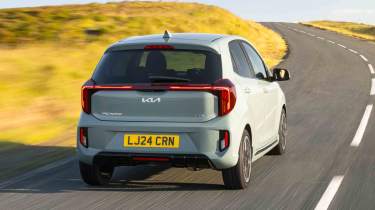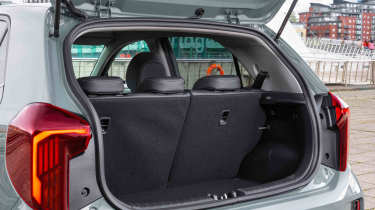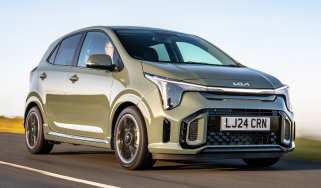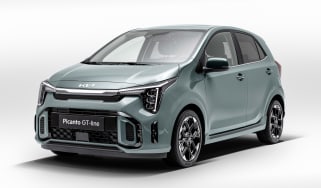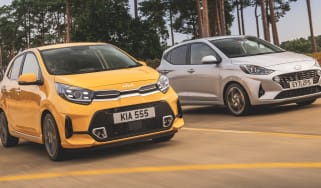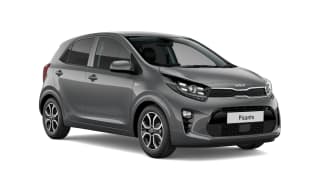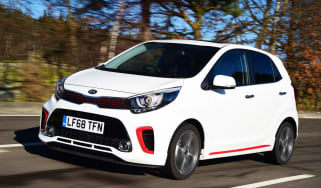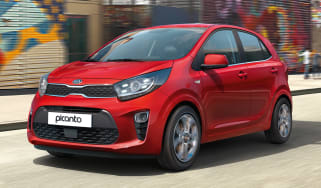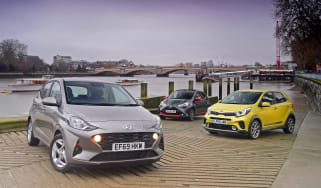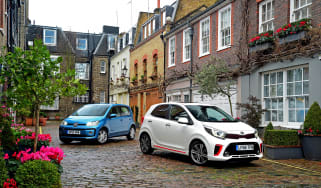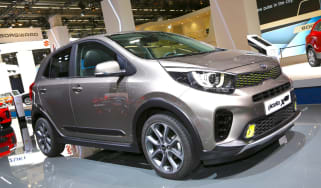Kia Picanto review
The Kia Picanto city car has plenty of kit and offers a grown-up drive to go with its sporty looks

Quick verdict
The latest Kia Picanto has gone through a significant glow-up, transformed from the drab and sparse first-generation car to this Mk3 model, while building on the stylish design of the Picanto Mk2. The latest Picanto is better equipped, has impressive interior space, and a grown-up driving experience.
The standard 1.0-litre petrol engine needs to be worked hard once out of the city (although the bigger 1.2 petrol model is a little better), but that’s typical for a city car. All in all, the Picanto is an enticing, likeable and easy-to-drive offering that should be on any city car buyer's shortlist
Kia Picanto: price, specs and rivals
Launched in 2017, the third-generation Picanto is the smallest car for sale in the Kia line-up. It's a strong contender in the city car class, thanks to impressive interior dimensions for its size, a competitive price list and low insurance and everyday running costs.
It faces tough competition from the likes of its sibling, the Hyundai i10, the pseudo SUV styling of the Toyota Aygo X as well as the bigger but more affordable Dacia Sandero.
Kia no longer offers a three-door Picanto, so your sole body option is a five-door hatchback. The Picanto comes in ‘2’, ‘3’, GT-Line and top-of-the-range GT-Line S models, plus a special edition called Shadow. The ‘2’ and ‘3’ trims are more conservatively styled than the sportier-looking GT-Line and GT-Line S cars. Prices start from just over £15,500, while the most expensive Picanto will set you back a little over £19,000.
Two petrol engines are offered in the Picanto: a 61bhp 1.0-litre, and a 76bhp 1.2-litre. Both are non-turbocharged three-cylinder petrol engines. Those after a bit more get up and go from their city car might want to look at the i10, which gets a more potent 89bhp 1.0-litre turbocharged engine. All versions of Picanto come with a five-speed manual gearbox as standard, with a five-speed automatic available as an option.
More reviews
Car group tests
- Toyota Aygo vs Kia Picanto: a used cheap city car shootout
- Hyundai i10 vs Kia Picanto: 2022 twin test review
- Hyundai i10 vs Toyota Aygo vs Kia Picanto
- Kia Picanto vs Volkswagen up!
- Skoda Citigo vs Kia Picanto vs Renault Twingo
Road tests
- New Kia Picanto 2024 facelift review: classy small car keeps big car appeal
- New Kia Picanto X-Line 2018 review
Used car tests
The entry-level Picanto in '2' trim comes with alloy wheels, air conditioning, electrically adjustable and heated door mirrors, an 8-inch touchscreen infotainment system with sat-nav, Apple CarPlay and Android Auto smartphone connectivity, plus a reversing camera system.
Move up to the '3' spec, and you get luxuries like wireless phone charging, electric folding door mirrors, LED headlights, and heated front seats and steering wheel.
Beyond that, the GT-Line and GT-Line S offer sporty looks, and in the case of the latter, the bigger 1.2-litre engine, blind spot monitoring, and an electric sunroof.
Engines, performance and drive
While it’s no longer overall than the previous version, the latest Kia Picanto has an extended wheelbase and shorter overhangs to give the Picanto a more dynamic appearance and tighter turning circle. The well-weighted and quick steering also contributes to the Picanto being a genuinely fun little car to drive.
Lengthening the wheelbase has improved the ride, so the Picanto feels relatively relaxed for its size while rolling over bumps at speed, although sharper ridges in the road can highlight a tendency for the rear suspension to pogo up and down. Around town, the Picanto copes reasonably well with ripped-up and rucked urban roads.
We found the Picanto 61bhp 1.0 to be a willing engine that’s flexible enough to keep up with busy traffic, and is allied to a slick five-speed gearbox that allows you to keep it on the boil. The gearing is fairly short, so you’ll find yourself changing gears regularly.
You will hear the little 1.0-litre engine thrum away in the background when tackling the odd motorway trip, as well as some road and wind noise.
0-62mph acceleration and top speed
The 61bhp 1.0-litre Kia Picanto does 0-62mph in 15.4 seconds (18.2 seconds for the automatic), while the 76bhp 1.2 cuts this down to 13.1 seconds (16.5 seconds for the automatic). For those needing something swifter, you’ll have to look towards the 1.0-litre turbo petrol found in the most expensive Hyundai i10, which cuts the 0-62mph sprint down to just over 10 seconds.
No version of the Picanto can quite breach the 100mph mark, with the 1.2 managing 98mph, and the 1.0-litre topping out at 90mph. Both of those figures are higher than the national speed limit in the UK and would only be newsworthy to those driving on unrestricted autobahns.
MPG, CO2 and running costs
Whichever way you look at it, the Kia Picanto is one of the most affordable cars money can buy. That goes for everything from list price, fuel, and other consumables.
Depending on the spec, the official fuel economy for the 61bhp 1.0-litre Picanto is 54.3mpg (whether you go for the automatic or manual), while the 1.2 varies from 51.4mpg for the manual to 50.4mpg for the automatic.
Likewise, the less powerful petrol engine is better when it comes to CO2 emissions, emitting 116g/km in manual form or 119g/km with the automatic. The bigger 1.2 puts out a little more CO2, at 124g/km for the manual and 128g/km for the automatic. The Toyota Aygo X produces slightly less CO2 and is in a lower Benefit-in-Kind (BiK) tax group, which might be important to some company car drivers.
Insurance groups
Insurance groups for the Kia Picanto range from groups 3 to 7, with the least costly being the 1.0-litre petrol, while the priciest is the 1.2-litre GT-Line S manual.
Depreciation
The Picanto is expected to maintain between 43 to 48 per cent of its resale value after three years or 36,000 miles, according to our expert data. The best version is predicted to be the 1.0-litre GT-Line, with the 1.0-litre ‘3’ trim automatic losing the most.
The Hyundai i10 does a little better, holding on to around 50 per cent of its value over the same period.
To get an accurate valuation for a specific model, check out our valuation tool...
Interior, design and technology
Kia says only 10 per cent of buyers in this sector opt for three-door models, so the company has sensibly decided to stop producing the less practical version of its entry-level car. The Picanto is focused on refinement and maturity, so the more practical five-door bodystyle is fitting.
Underneath, the Picanto uses MacPherson strut suspension at the front and a torsion beam at the rear, while its platform has also grown in size with a 15mm-longer wheelbase, helping create more room inside.
There are higher-quality materials inside over its predecessor. While there still aren’t any soft-touch materials on the dashboard, as you’ll find in some versions of Dacia Sandero, it’s still an improvement over the old model.
You get all the basics with the '2' specification, including an 8-inch touchscreen with sat-nav, Bluetooth, 14-inch alloys, air-con and all-around electric windows. You’ll have to upgrade to the ‘3’ trim model and above if you want wireless phone charging.
Black and grey cloth seat trim comes as standard, but buyers can get artificial leather on ‘3’ and GT-Line S trims. GT-Line and GT-Line S cars get sportier details inside and out, including aluminium pedals.
Sat-nav, stereo and infotainment
All versions of the Kia Picanto now come with an 8-inch touchscreen as standard, matching the similarly priced mid-range Dacia Sandero Expression, which also gets an 8-inch screen. The Sandero doesn’t come with sat-nav, whereas the Picanto does. You can connect your smartphone via Apple CarPlay or Android Auto, and wireless phone charging is available with the Picanto on ‘3’, Shadow, and GT-Line S trims.
The infotainment system is simple and easy to use, with a logical layout that makes changing the radio station or making a call straightforward while out on the move.
A four-speaker stereo comes standard with a DAB radio. The sound quality is OK, although you will be increasing the volume at higher speeds to contend with the road noise.
Practicality, comfort and boot space
Few people buy a city car for outright practicality, but for those interested in a tiny car with generous interior dimensions, the Kia Picanto impresses.
Being five-door only means getting in and out of the back seats is infinitely easier than in the previous three-door model. While the Picanto range comes with five seats, it’s much more comfortable as a four-seater, given that three across the back seat is a squeeze.
Thanks to the thin pillars and upright rear screen, visibility is good, and all versions come with a reversing camera and rear parking sensors as standard. Other practical features include a small central armrest, some usable door bins and a decent glovebox. You’ll also find a couple of cupholders ahead of the gear lever.
Size
The Mk3 Picanto is no longer than the car it replaced, but by extending the distance between the front and rear wheels, the engineers increased cabin space for all passengers.
At 3,595mm long, the Picanto is among the smallest cars on sale, and beats the closely related Hyundai i10 for dinky dimensions. At a narrow 1,595mm in width, it’s easy to park, too.
Leg room, head room and passenger space
The longer wheelbase has freed up more knee room in the rear compared with the previous Picanto, and decent sized door openings mean it’s easy to get into the back. Storage and ergonomics are fine, although seat comfort could be better for longer journeys.
If you need to put child seats in the Picanto, you will find a pair of ISOFIX mounting points on the rear bench's outer positions.
For anyone looking to carry adults more often in the back of their car, it might be worthwhile considering the Dacia Sandero, a larger supermini that undercuts the Picanto in terms of price.
Boot space
The Kia Picanto actually boasts best-in-class boot space. Enlarging the Picanto’s platform has created more luggage room and cabin space. The boot is 255 litres with the seats up (bigger than the MINI Cooper), and rises to 1,010 litres with them folded down.
Few people buy a city car to carry really big loads, but on the odd occasion when space is a priority, the Picanto can deliver. In comparison, a Hyundai i10 is a few litres behind, at 252 litres. However, the larger Dacia Sandero has a bigger 328-litre boot, and would be more useful if you regularly car a child’s pushchair.
Reliability and Safety
Kia has built a hard-earned reputation for reliability over the past two decades, cemented by a bold seven-year/100,000-mile warranty. In our 2024 Driver Power owner satisfaction survey, the Kia brand finished 3rd out of 32 manufacturers included in the survey, while the Picanto managed an excellent 12th place finish out of 50 models,
The third-generation Picanto was crash tested by safety experts Euro NCAP in 2017, and the car received a three-star out of five score for cars without Automatic Emergency Braking (AEB), and a four-star out of five result for those with AEB. Since then, the test has become much tougher, which means the original scores have expired.
That’s a shame because the revised Picanto comes with more safety assistance features as standard (including AEB across the range), such as active lane keep assistance to keep you within your lane, and a speed limit recognition system. Even blind spot monitoring to warn of cars alongside when you indicate to change lanes on the motorway is available on the top-of-the-range GT-Line S trim.
If having a car with a current safety score is a big concern for you, then take a look at the Toyota Aygo X, which features a four-star Euro NCAP score from 2022.
Warranty
All Kias come with a seven-year/100,000-mile warranty. While most people won’t keep their car that long, it does give the Picanto extra appeal when you come to sell it because it’ll still have a bit of warranty cover left. The Hyundai i10 (Kia’s sibling brand) comes with a five-year guarantee, while the basic three-year/60,000-mile warranty of the Toyota Aygo X can be extended by one year/10,000 miles at a time through annual servicing at a Toyota dealer, up to a maximum of 10 years or 100,000 miles, whichever comes first.
Servicing
Kia Care is the manufacturer's service plan package, which provides fixed servicing costs specific to the age and mileage of your vehicle.
Service intervals for the Picanto are every 12-months or 10,000-miles – whichever comes first.



